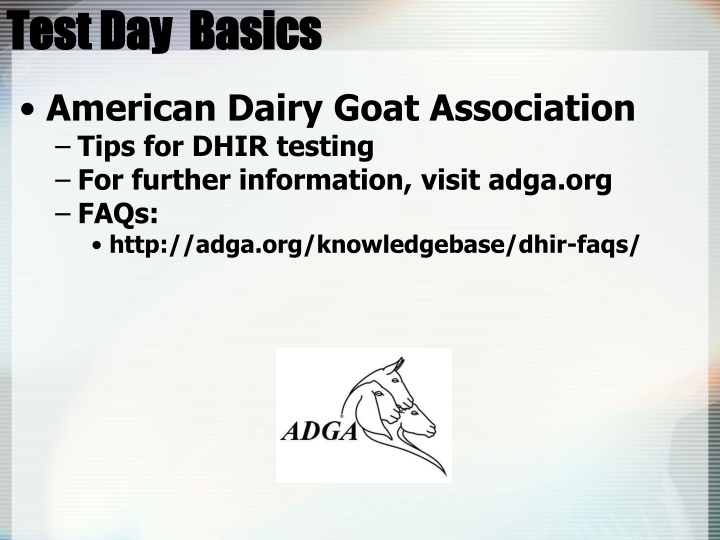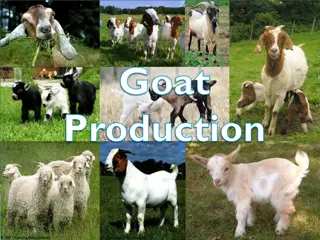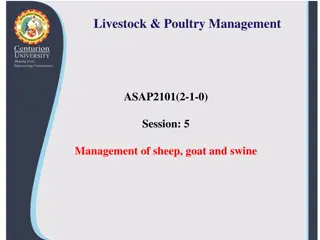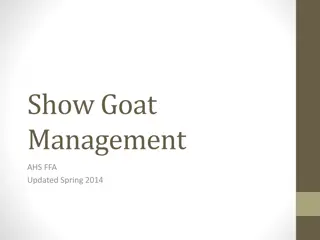American Dairy Goat Association Test Day Basics and Procedures
Learn about the essential procedures and guidelines for DHIR testing by the American Dairy Goat Association (ADGA). This comprehensive guide covers the sequence of events, data collection, preparation, professional attitude, and equipment needed for a successful testing day. Follow these tips to ensure accurate and reliable results for your goat herd.
Download Presentation

Please find below an Image/Link to download the presentation.
The content on the website is provided AS IS for your information and personal use only. It may not be sold, licensed, or shared on other websites without obtaining consent from the author.If you encounter any issues during the download, it is possible that the publisher has removed the file from their server.
You are allowed to download the files provided on this website for personal or commercial use, subject to the condition that they are used lawfully. All files are the property of their respective owners.
The content on the website is provided AS IS for your information and personal use only. It may not be sold, licensed, or shared on other websites without obtaining consent from the author.
E N D
Presentation Transcript
Test Day Basics Test Day Basics American Dairy Goat Association Tips for DHIR testing For further information, visit adga.org FAQs: http://adga.org/knowledgebase/dhir-faqs/
Test Day Test Day - -Sequence of Events Sequence of Events Weights & samples taken at farm Samples & barnsheets/data upload to the lab Lab tests for fat, protein, & SCC Lab results & data to DRPC DRPC enters data DRPC sends data to: member/CDCB Herd owner uses the data
Professional Attitude Professional Attitude Testers & Owner Samplers are representing DHI! On-Time (testers) 30 minutes early for paperwork Ready to Test Have your Stuff Clean Clothes - Bio-security Rubber Boots - Sanitized Confidentiality
Box of Stuff Box of Stuff Extra pencils & pens Sanitizer Watch Flashlight Footwear Paintstick Scale? Dipper? Buckets? Sample bottles, Shipper
Data Collected Data Collected Identification Parentage and Offspring Production Data Drying Culls/Sold Animals Reproduction Management Kidding Breeding Health Records
Preparation Preparation Have clean equipment Scales Dipper Sample Vials Biosecurity Boots Clothing Equipment
Scales & Meters Scales & Meters Tester s scale/meter or Owner s scale/meter must have certification within the last year.
Tare the Scale Tare the Scale Zero the scale to the pail used for weighing prior to starting. Note clock in background!
Milking Time Milking Time Ensure that the 24 hour period is correct Organized in the parlor sheets, sample vials, racks, computer Test day procedures are important Should represent normal milking days as closely as possible Working conditions conducive to accurate representation of the herd
Getting Started Getting Started - -Visible & Permanent ID Visible & Permanent ID Check tags each test day Tag = control # or ID/Name Check tattoos on any herd additions, Occasionally spot check EVERY VERIFICATION
Observe Milking Observe Milking Observe milking You are the Supervisor! (S. Hank) Note Start time when milking 1stdoe in herd Note Stop time after last doe in herd is milked
Weigh Milk Weigh Milk Weigh milk and record to 10thof a pound. Convert if using a lb/oz scale. Record on cow barnsheet or enter into program
Sampling Sampling Obtain a representative Sample! What affects test sample: Milking Interval (AM PM, Influence of stage of milking on composition Influence of stage of lactation Feed Sample Handling Preservatives Avoid temperature extremes Ship quickly
Sampling Technique Sampling Technique Pour three times back and forth or stir, stir, stir because We want a representative sample and goat milk has smaller fat molecules, but it is not naturally homogenized.
Taking the Sample Taking the Sample Sample must be from all milk obtained from the doe For Standard test, a half sample is taken at each test For alternate component test plans, a full sample is taken If properly mixed, it doesn t matter if sample is from top, bottom or middle
Filling Filling Proper Sampling Technique Fill sample to slightly less than 1/2 full on 1st milking Same vial to 80% full on 2nd milking
Vials Vials Check to make sure preservative is present Label lid with Sample # or Control # or however your DHIA prefers Leave inch space at top Gently mix sampled milk with preservative OLD STYLE Cap picture NEW have attached SNAP CAPS
Entering Information Entering Information Garbage in = garbage out Pre-test Status changes kidded, dried off, sold, aborted Reproductive changes heats, breeding Herd health Identification Corrections
Checklist Checklist Weights Sample # Dated Signed Herd Info Stop/start times Sampled check VT check
Sample Storage Sample Storage Room temperature if not too hot Store upright Keep out of sunlight Refrigerate if over 75 Secure storage is tester s responsibility
Test Test- -Day Checklist Day Checklist Weights and samples on every milking doe Dry, sold, or died on remainder Enrollment data on new animals Samples mixed & packed Protect from sunlight Rock & Roll to disperse preservative Chill when herd finished (DO NOT FREEZE) Properly marked sample vials Paperwork included w/notes or corrections
Completing the Test Completing the Test Check for correct status codes/CAR codes Samples properly marked? Barnsheets dated, signed, marked for V if applicable? Date of test is last weighing/sampling date Pack and ship
Shipping Shipping Separate groups Herdcode at 1st and last sample if more than one herd Shipping boxes available or make own egg cartons (prevent potential leaking) Secure lids Cool pack if hot weather Insert sheets outside of samples & in plastic bag.
Verification Testing Verification Testing Perform on animal or herd basis, dependent on Test Plan or goal Required for: Top Ten Recognition (individual) Innovative Test Plans (herd) Owner Sampler (herd) Responsibility of herd owner Do it Early
Verification Testing Requires VT form, even if at a 1-day If two testers, both testers complete portions of the VT form Both testers sign if two DHIA Manager must sign Tips Use copy of herd summary from previous test Large herds Empty for pre-milk























